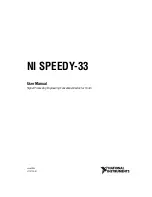
Chapter 1
NI SPEEDY-33 Overview
1-2
ni.com
Theory of Operation
The NI SPEEDY-33 is a low-cost, high-performance floating-point
TMS320VC33-based DSP system connected to a standard PC through the
USB port. This easy-to-use system supports a variety of DSP processing,
including audio applications with two input/output analog channels
sampled at 48 kHz, and other applications with onboard digital I/O for
controlling motors/servos. The NI SPEEDY-33 features 34 K
×
32 words
of on-chip memory. The 512 K
×
8 onboard flash memory allows for
storage of both the program application (programmed with the LabVIEW
DSP Module), as well as data such as tables, sound waveforms, and so on.
The NI SPEEDY-33 has eight lines
of digital I/O, arranged as an eight-bit
switch input port, and eight digital output LEDs. The digital I/O lines can
be programmed with the LabVIEW DSP Module software. The eight
inputs and eight outputs are also accessible through the simple expansion
digital I/O connector. After the flash memory is programmed, the
NI SPEEDY-33 can be unplugged from the PC and run in standalone mode.
Safety Information
The following section contains important safety information that you must
follow when installing and using the module.
Do not operate the module in a manner not specified in this document.
Misuse of the module can result in a hazard. You can compromise the safety
protection built into the module if the module is damaged in any way. If the
module is damaged, return it to National Instruments (NI) for repair.
Do not substitute parts or modify the module except as described in this
document. Use the module only with the chassis, modules, accessories, and
cables specified in the installation instructions. You must have all covers
and filler panels installed during operation of the module.
Do not operate the module in an explosive atmosphere or where there may
be flammable gases or fumes. If you must operate the module in such an
environment, it must be in a suitably rated enclosure.
If you need to clean the module, use a soft, nonmetallic brush. Make sure
that the module is completely dry and free from contaminants before
returning it to service.










































